Two common tools used to manage pH are pH dosers and pH controllers. This article will explore the differences between these devices, their applications, and how they impact your hydroponic system’s efficiency and plant health.
See How Growee Can Save You Time By Automating Your Plants Feeding
Water pH – Automated pH Up and Down Control
Nutrients Mixing – Automated Nutrient Dosing with Target EC / PPM Control.
Control From Anywhere – WiFi Connection and mobile App
Why Do You Need to Change the Hydroponics System Water pH?
Hydroponic systems rely on precise pH levels to ensure plants can absorb nutrients effectively. pH drift, a common issue in hydroponics, can make it challenging to maintain these levels. This drift occurs when the pH of the nutrient solution changes over time, impacting nutrient absorption and plant health. Regularly adjusting the pH prevents nutrient lockout and promotes optimal growth.
Another reason for adjusting the pH level is the natural pH level of tap water, which is used as a base for mixing the feeding solution. In most urban locations, the tap water pH is typically between 7.5 and 8.5, whereas the optimal pH for most plants, especially high-value crops like cannabis, is between 5.8 and 6.2.
Adjusting the pH ensures that your plants receive a nutrient solution within their preferred range, fostering better growth and yields.
Two Main Groups of Hydroponic Systems:
1. Recirculating Hydroponic Systems:
Recirculating hydroponic systems are setups where the nutrient solution is reused. The same solution is sent through the system again and again. This method makes sure that plants always have plenty of nutrients and helps save water and nutrients.
NFT (Nutrient Film Technique):
- In an NFT system, a thin layer of nutrient solution flows over the plant roots. The roots absorb the nutrients, and then the solution goes back to the reservoir to be used again.
DWC (Deep Water Culture):
- DWC systems keep plant roots submerged in a nutrient-rich, oxygenated water solution. The roots stay in this solution, which is continuously supplied with oxygen to keep the plants healthy.
RDWC (Recirculating Deep Water Culture):
- RDWC systems are similar to DWC but connect multiple units. The nutrient solution moves between these units, making sure all plants get an even amount of nutrients.
Ebb and Flow:
- Also called flood and drain, this system floods the grow tray with nutrient solution and then drains it back into the reservoir. This cycle repeats throughout the day, giving plants access to nutrients and oxygen.
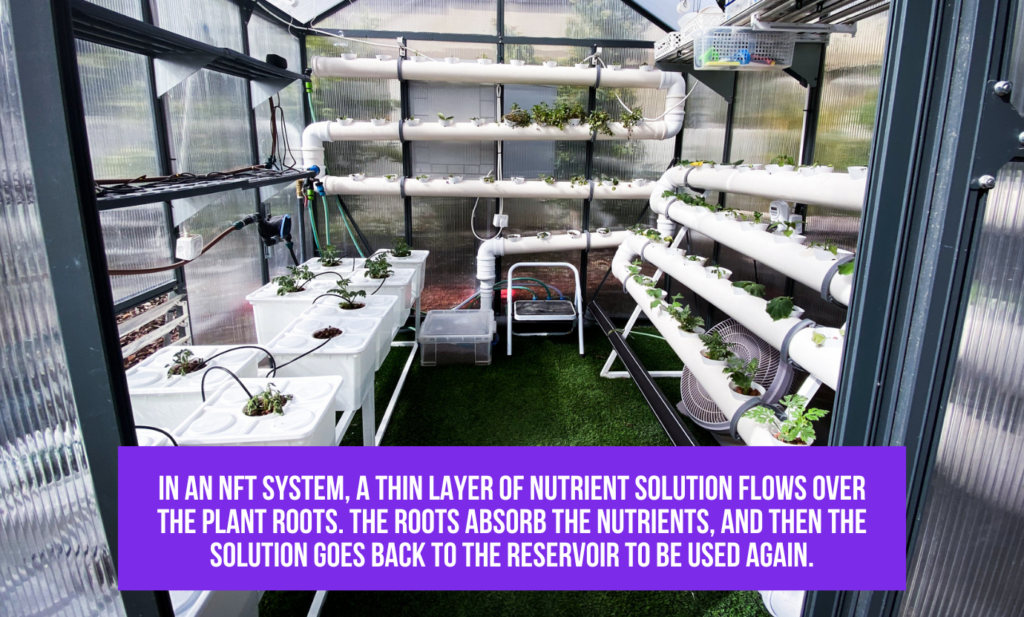
Our take on Recirculating Hydroponic Systems:
A more sustainable approach that efficiently reuses nutrients and water, saving resources. However, they can be harder to control due to changes in water chemistry from continuous circulation.
2. Direct Feed Systems:
These systems use more nutrients and water since they are not recirculated, making them less sustainable. However, large batch tanks can save time in mixing feeding solutions.
Batch Tank with Grow Tables or Trains:
In this setup, the nutrient solution is mixed in a batch tank and then distributed to the plants on grow tables or trains. The solution is typically used once and not recirculated, making the system easy to manage but potentially less efficient.
Drain to Waste Systems:
Drain-to-waste systems provide a continuous feed of nutrient solution to the plants, which then drains away after passing through the roots. This ensures fresh nutrients are always available, but it can lead to higher water and nutrient use.
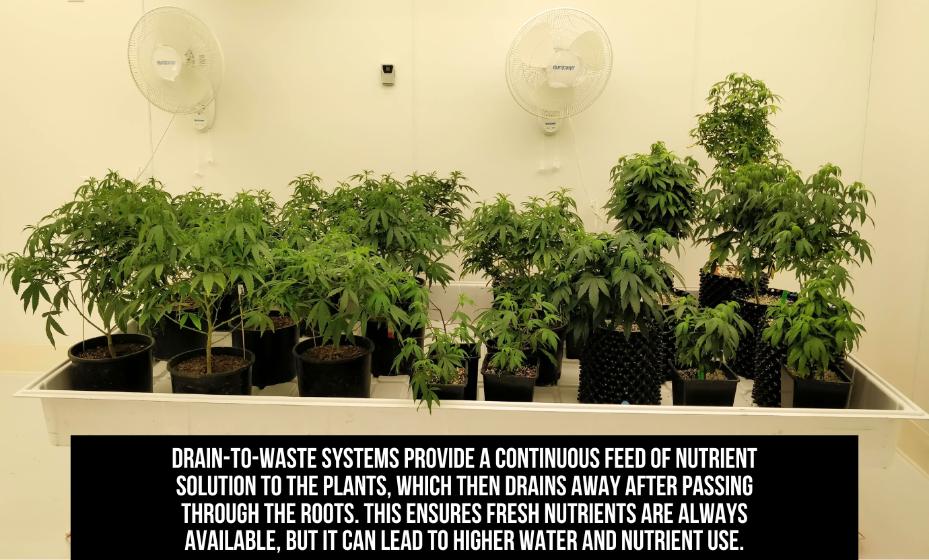
Hydroponics growers and urban farmers looking to add some kind of automation to direct feed systems will typically use mechanical injection systems like Dosatron. Before we explore the alternatives, let’s understand the difference between a pH doser and a pH controller.
What is a pH Doser?
A pH doser, sometimes referred to by growers as a pH machine, is a device designed to add pH-adjusting solutions to the nutrient reservoir. It operates by injecting a set amount of pH solution, which helps bring the pH level to the desired range. pH dosers are commonly used in direct feed setups and appear in two main versions: mechanical injection and digital injection systems. This pH machine ensures that the nutrient solution maintains the optimal pH for plant growth.
How The Mechanical Injector System, Like Dosatron, Works:
A mechanical injector automates nutrient and pH adjustment in direct feed systems. As water flows through the unit, it creates suction to draw in the pH-adjusting solution or nutrients from a separate container.
The user sets the injection ratio by turning a knob, determining the amount of milliliters of solution mixed per gallon of water based on their experience. This mixed solution is then delivered directly to the plants, ensuring consistent and accurate feeding without the need for manual mixing.
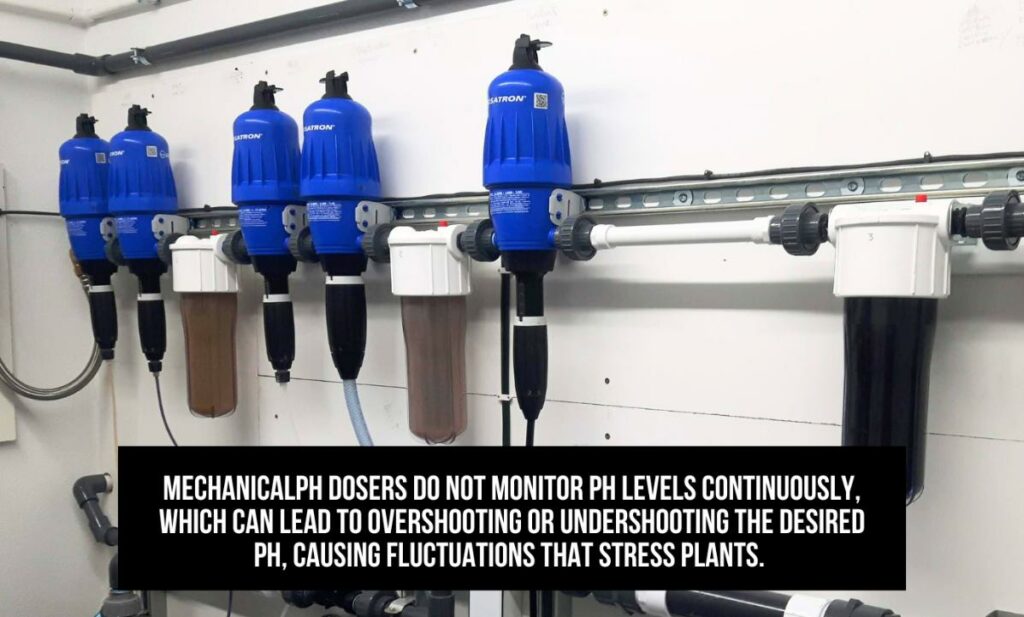
How The Digital Injector System Works:
Digital injector systems for direct feed work on the same principle as mechanical injectors, but with a key difference: instead of water flowing through the system, it flows through a flow meter. The digital pump then injects the precise amount of pH-adjusting solution set by the user, based on a predefined milliliters-per-gallon ratio. This ensures accurate and consistent nutrient delivery to the plants.
Disadvantages of Using a pH Doser – Lack of pH Monitoring:
Mechanical pH dosers do not monitor pH levels continuously, which can lead to overshooting or undershooting the desired pH, causing fluctuations that stress plants. They often require manual calibration and adjustment, which can be extremely time-consuming and challenging to determine the right amount of pH material injection per gallon flowing through the system, making it prone to human error.
Additionally, without a feedback loop, pH dosers cannot make real-time adjustments based on the actual pH levels in the system. This lack of real-time monitoring and adjustment can result in imprecise pH control, potentially harming plant health and growth.
Why Using a pH Doser in Direct Feed Can Create Overshooting in pH and Harm the Plants?
Using a pH doser in direct feed systems can lead to overshooting of pH levels and harm plants because the doser does not monitor pH levels continuously. This lack of real-time feedback means that the doser cannot make precise adjustments based on the actual pH levels in the system. When the pH solution is injected without continuous monitoring, it can easily add too much or too little, causing the pH to swing too high or too low.
These fluctuations can stress plants, lead to nutrient lockout, and ultimately impair plant health and growth. The manual calibration required for pH dosers is also time-consuming and prone to error, further increasing the risk of incorrect pH levels.
What is a pH Controller?
The Growee pH Controller is a smart pH dosing and control system that continuously monitors and adjusts the pH levels in your hydroponic system. It uses a feedback loop to ensure the pH stays within the desired range, providing a stable environment for plant growth.
Its main application is in recirculating systems, where the water returns to the system, and the controller continuously monitors and adjusts the water’s pH. This helps maintain optimal conditions for the plants at all times.
If you are using direct feed applications, such as batch tanks or drain-to-waste systems, you can also benefit from pH controllers. In these setups, the pH controller balances the pH of the feeding solution inside the feeding tank, ensuring that the solution used to feed the plants is at the optimal pH level.
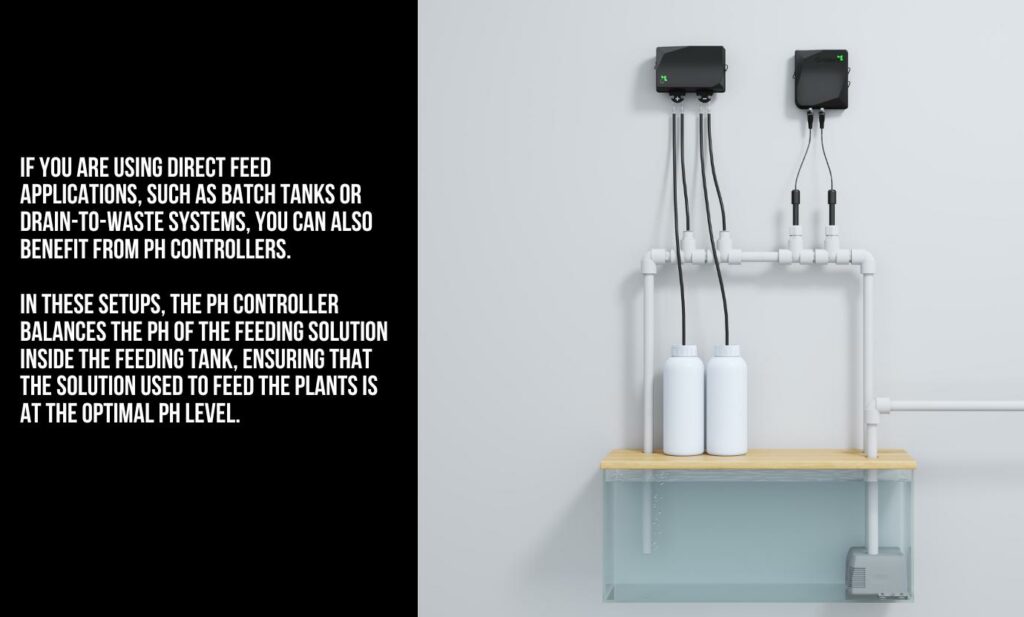
Why Growee’s pH Control Will Make Sure You Will Not Have Overshoot:
The Growee pH control system is equipped with sensors that provide real-time data on the pH levels in the nutrient solution. This continuous monitoring allows the controller to make precise adjustments, preventing overshooting and maintaining stable pH levels. This ensures that plants are always in an optimal environment for nutrient absorption.
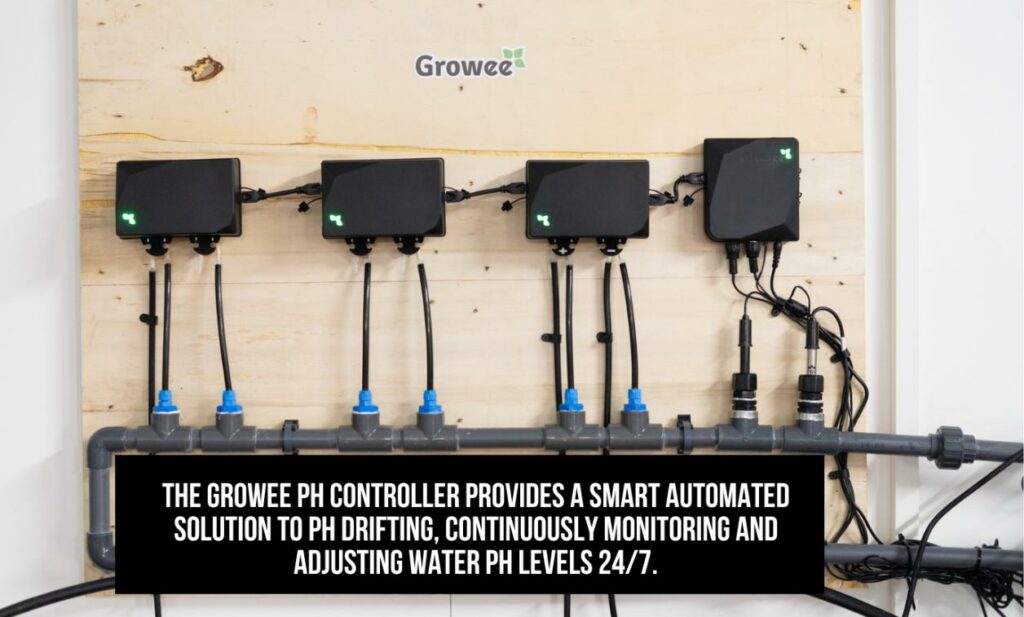
How Does the Growee Dual pH Controller Protect Your Plants and Keep the pH on Point?
The Growee Dual pH Controller uses advanced algorithms to manage both pH up and pH down solutions, ensuring a balanced pH environment. Its continuous feedback loop adjusts the pH in real time, protecting plants from sudden pH swings. This stability promotes healthier growth and higher yields.
Growee vs. Dosatron for Controlling Indoor Cannabis Growing pH:
For indoor cannabis growing, maintaining stable pH levels is critical. While Dosatron pH dosers provide a basic solution, Growee pH Controllers offer superior precision and ease of use.
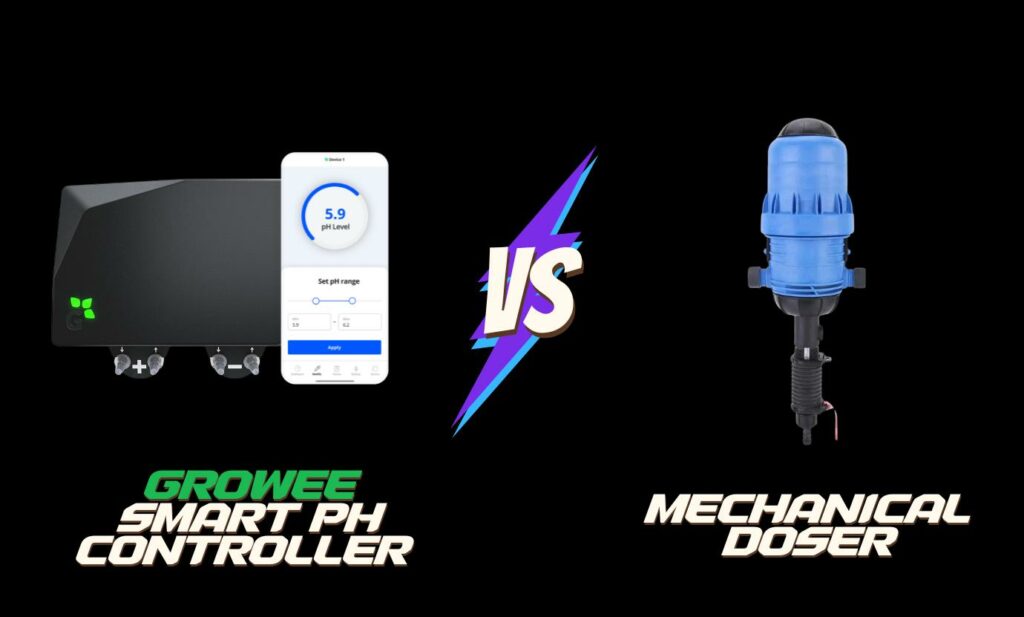
Growee’s continuous monitoring and automated adjustments ensure that your cannabis plants receive the best possible care, leading to healthier plants and better harvests.
FAQ
Why is maintaining the correct pH level important in hydroponics?
Maintaining the correct pH level in hydroponics is crucial because it directly affects the availability of nutrients to plants. If the pH is too high or too low, certain nutrients become unavailable, leading to nutrient deficiencies and poor plant growth. The optimal pH range for most hydroponic systems is between 5.8 and 6.2, which ensures that nutrients are readily available for absorption by the plants.
What is pH drift, and how does it affect hydroponic systems?
pH drift refers to the gradual change in pH levels of the nutrient solution over time. This can happen due to several factors, including nutrient uptake by plants, microbial activity, and water evaporation. pH drift can lead to nutrient lockout, where plants are unable to absorb essential nutrients, ultimately affecting plant health and yield. Regularly monitoring and adjusting the pH helps mitigate the impact of pH drift.
How do Mechanical pH dosers work, and what are their limitations?
pH dosers add pH-adjusting solutions to the nutrient reservoir to bring the pH to the desired level. They come in mechanical and digital versions. Mechanical dosers use suction created by water flow to inject pH solutions, while digital dosers use flow meters for precise control.
The main limitation of pH dosers is the lack of continuous monitoring and feedback, which can lead to overshooting or undershooting the pH, causing stress to the plants and potential nutrient lockout.
How does a pH controller improve pH management in hydroponics?
A pH controller, such as the Growee pH Controller, continuously monitors and adjusts pH levels in real-time. It uses sensors and a feedback loop to ensure that the pH stays within the optimal range. This prevents pH fluctuations, provides a stable environment for nutrient absorption, and reduces the risk of nutrient lockout. pH controllers are particularly beneficial in recirculating systems but can also be used effectively in direct feed systems.
Why Growee's pH Controller Is Better Than Traditional pH Dosers?
The Growee pH Controller offers several advantages over traditional direct-feed mechanical pH dosers. It provides continuous real-time monitoring and adjustment of pH levels, ensuring precise control and stability.
Using advanced algorithms, cloud, and IoT technology, the Growee system manages both pH-up and pH-down solutions, preventing overshooting and maintaining an optimal pH balance. This results in healthier plants and higher yields, especially in high-value crops like cannabis.
Can I use a pH controller in a direct-feed hydroponic system?
Yes, a pH controller can be used in direct-feed hydroponic systems, but you will need to make adjustments and add a feeding solution mixing tank. In these setups, the pH controller balances the pH of the feeding solution inside the feeding tank. This ensures that the solution used to feed the plants is at the optimal pH level, providing consistent and precise nutrient delivery.
How does the lack of a feedback loop in pH dosers impact plant health?
The absence of a feedback loop in pH dosers means they cannot make real-time adjustments based on the actual pH levels in the system. This can result in the doser adding too much or too little pH-adjusting solution, causing pH levels to swing too high or too low. Such fluctuations can stress plants, lead to nutrient lockout, and impair plant growth and health. Continuous monitoring and real-time adjustments provided by pH controllers help avoid these issues.
What is the role of continuous pH monitoring in hydroponic systems?
Continuous pH monitoring is essential for maintaining a stable nutrient solution environment. It allows for real-time adjustments to pH levels, ensuring that plants receive nutrients within their optimal pH range. This stability prevents nutrient lockout, reduces plant stress, and promotes healthier growth and higher yields. Continuous monitoring is a key feature of pH controllers, making them more effective than traditional direct-feed mechanical pH dosers.
Is a pH Doser the Same as a pH Machine?
Yes, a pH doser and a pH machine refer to the same type of device. Both are designed to add pH-adjusting solutions to the nutrient reservoir in hydroponic systems, helping to maintain the desired pH level for optimal plant growth.



